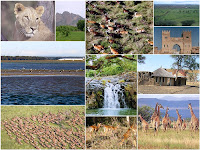Sudan's Wildlife Undiscovered
Before the wars and instability that Sudan has known since its 'independence' from the British and then the Egyptians, the country must have had a fascinating, abundant and a variety of wildlife. With its vast green plains, rivers and swamps - elephants, rhinos, lions, buffaloes, leopards, cheetahs, birds and many other animals, must have roamed in many parts of the country.
Presently, not many wild animals are left in the North; Southern Sudan, still has abundant wildlife. The deep swamps of the Sudd, is abundant with wildlife like the white-eared kob and Nile lechwe (Kobus megaceros). Nobody seems to know the true numbers and distribution of Sudan's wildlife. With the country now settling down, both in the North and the South - studies can now be undertaken on this. Today, there are four known national parks in the Sudan: Dinder, Nimule, Southern and Sanganeb; Sanganeb and Dungonab on the Red Sea, are said to contain some of the best and most unspoiled coral reefs in the world; the Dongonab area is relatively remote and rarely visited. For the most part, tourism consists of international diving holidays, with visitors flying to Port Sudan and residing on large hotel boats, which travel to anchor at the various diving sites for a few days at a time.
There are a number of other game reserves around the country: the Suakin Archipelago, comprises coral reefs which surrounds a number of sandy islands approximately 20 km south-east of Suakin; it has important nesting sites for marine turtles and sea birds; the Khor Kilab Bird Sanctuary is a small estuarine area on the south side of Port Sudan harbor; the Abu Hashish area, is another small area on the eastern side of the new Green port, containing numerous coral reefs; and Shuab Rumi, is another area of coral reefs 50 km north of Port Sudan. For bird lovers, Sudan has many. Most of these wildlife are under intense pressure from human encroachment; what Sudan needs now, is for these areas to be protected and properly managed; and conservation measures have to be applied.
Presently, not many wild animals are left in the North; Southern Sudan, still has abundant wildlife. The deep swamps of the Sudd, is abundant with wildlife like the white-eared kob and Nile lechwe (Kobus megaceros). Nobody seems to know the true numbers and distribution of Sudan's wildlife. With the country now settling down, both in the North and the South - studies can now be undertaken on this. Today, there are four known national parks in the Sudan: Dinder, Nimule, Southern and Sanganeb; Sanganeb and Dungonab on the Red Sea, are said to contain some of the best and most unspoiled coral reefs in the world; the Dongonab area is relatively remote and rarely visited. For the most part, tourism consists of international diving holidays, with visitors flying to Port Sudan and residing on large hotel boats, which travel to anchor at the various diving sites for a few days at a time.
There are a number of other game reserves around the country: the Suakin Archipelago, comprises coral reefs which surrounds a number of sandy islands approximately 20 km south-east of Suakin; it has important nesting sites for marine turtles and sea birds; the Khor Kilab Bird Sanctuary is a small estuarine area on the south side of Port Sudan harbor; the Abu Hashish area, is another small area on the eastern side of the new Green port, containing numerous coral reefs; and Shuab Rumi, is another area of coral reefs 50 km north of Port Sudan. For bird lovers, Sudan has many. Most of these wildlife are under intense pressure from human encroachment; what Sudan needs now, is for these areas to be protected and properly managed; and conservation measures have to be applied.


